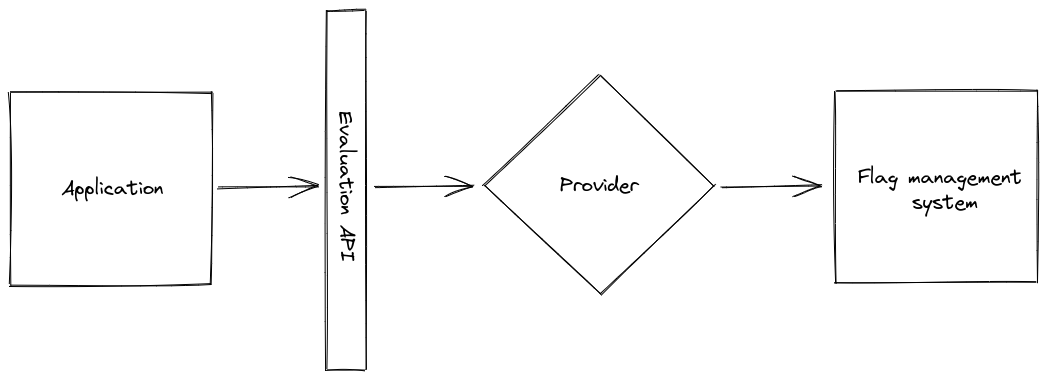2. Provider
Overview
The provider API defines interfaces that Provider Authors can use to abstract a particular flag management system, thus enabling the use of the evaluation API by Application Authors.
Providers are the "translator" between the flag evaluation calls made in application code, and the flag management system that stores flags and in some cases evaluates flags. At a minimum, providers should implement some basic evaluation methods which return flag values of the expected type. In addition, providers may transform the evaluation context appropriately in order to be used in dynamic evaluation of their associated flag management system, provide insight into why evaluation proceeded the way it did, and expose configuration options for their associated flag management system. Hypothetical provider implementations might wrap a vendor SDK, embed an REST client, or read flags from a local file.

2.1. Feature Provider Interface
Requirement 2.1.1
The provider interface MUST define a
metadatamember or accessor, containing anamefield or accessor of type string, which identifies the provider implementation.
provider.getMetadata().getName(); // "my-custom-provider"
2.2 Flag Value Resolution
Providers are implementations of the feature provider interface, which may wrap vendor SDKs, REST API clients, or otherwise resolve flag values from the runtime environment.
Requirement 2.2.1
The
feature providerinterface MUST define methods to resolve flag values, with parametersflag key(string, required),default value(boolean | number | string | structure, required) andevaluation context(optional), which returns aresolution detailsstructure.
// example flag resolution function
resolveBooleanValue(flagKey, defaultValue, context);
see: flag resolution structure, flag value resolution
Condition 2.2.2
The implementing language type system differentiates between strings, numbers, booleans and structures.
Conditional Requirement 2.2.2.1
The
feature providerinterface MUST define methods for typed flag resolution, including boolean, numeric, string, and structure.
// example boolean flag value resolution
ResolutionDetails resolveBooleanValue(string flagKey, boolean defaultValue, context: EvaluationContext);
// example string flag value resolution
ResolutionDetails resolveStringValue(string flagKey, string defaultValue, context: EvaluationContext);
// example number flag value resolution
ResolutionDetails resolveNumberValue(string flagKey, number defaultValue, context: EvaluationContext);
// example structure flag value resolution
ResolutionDetails resolveStructureValue(string flagKey, JsonObject defaultValue, context: EvaluationContext);
Requirement 2.2.3
In cases of normal execution, the
providerMUST populate theresolution detailsstructure'svaluefield with the resolved flag value.
Requirement 2.2.4
In cases of normal execution, the
providerSHOULD populate theresolution detailsstructure'svariantfield with a string identifier corresponding to the returned flag value.
For example, the flag value might be 3.14159265359, and the variant field's value might be "pi".
The value of the variant field might only be meaningful in the context of the flag management system associated with the provider. For example, the variant may be a UUID corresponding to the variant in the flag management system, or an index corresponding to the variant in the flag management system.
Requirement 2.2.5
The
providerSHOULD populate theresolution detailsstructure'sreasonfield with"STATIC","DEFAULT","TARGETING_MATCH","SPLIT","CACHED","DISABLED","UNKNOWN","ERROR"or some other string indicating the semantic reason for the returned flag value.
As indicated in the definition of the resolution details structure, the reason should be a string. This allows providers to reflect accurately why a flag was resolved to a particular value.
Requirement 2.2.6
In cases of normal execution, the
providerMUST NOT populate theresolution detailsstructure'serror codefield, or otherwise must populate it with a null or falsy value.
Requirement 2.2.7
In cases of abnormal execution, the
providerMUST indicate an error using the idioms of the implementation language, with an associatederror codeand optional associatederror message.
The provider might throw an exception, return an error, or populate the error code object on the returned resolution details structure to indicate a problem during flag value resolution.
See error code for details.
// example throwing an exception with an error code and optional error message.
throw new ProviderError(ErrorCode.INVALID_CONTEXT, "The 'foo' attribute must be a string.");
Condition 2.2.8
The implementation language supports generics (or an equivalent feature).
Conditional Requirement 2.2.8.1
The
resolution detailsstructure SHOULD accept a generic argument (or use an equivalent language feature) which indicates the type of the wrappedvaluefield.
// example boolean flag value resolution with generic argument
ResolutionDetails<boolean> resolveBooleanValue(string flagKey, boolean defaultValue, context: EvaluationContext);
// example string flag value resolution with generic argument
ResolutionDetails<string> resolveStringValue(string flagKey, string defaultValue, context: EvaluationContext);
// example number flag value resolution with generic argument
ResolutionDetails<number> resolveNumberValue(string flagKey, number defaultValue, context: EvaluationContext);
// example structure flag value resolution with generic argument
ResolutionDetails<MyStruct> resolveStructureValue(string flagKey, MyStruct defaultValue, context: EvaluationContext);
2.3. Provider hooks
A provider hook exposes a mechanism for provider authors to register hooks to tap into various stages of the flag evaluation lifecycle. These hooks can be used to perform side effects and mutate the context for purposes of the provider. Provider hooks are not configured or controlled by the application author.
Requirement 2.3.1
The provider interface MUST define a
provider hookmechanism which can be optionally implemented in order to addhookinstances to the evaluation life-cycle.
class MyProvider implements Provider {
//...
readonly hooks: Hook[] = [new MyProviderHook()];
// ..or alternatively..
getProviderHooks(): Hook[] {
return [new MyProviderHook()];
}
//...
}
Requirement 2.3.2
In cases of normal execution, the
providerMUST NOT populate theresolution detailsstructure'serror messagefield, or otherwise must populate it with a null or falsy value.
Requirement 2.3.3
In cases of abnormal execution, the
resolution detailsstructure'serror messagefield MAY contain a string containing additional detail about the nature of the error.
